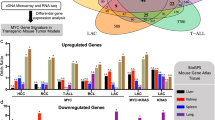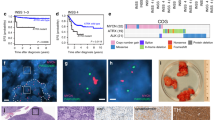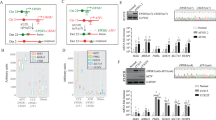Abstract
The N-myc gene, which is distantly related to the proto-oncogene c-myc, was first detected as an amplified sequence in human neuroblastoma cell lines and tumours1,2. It has since been revealed that there is up to a 300-fold amplification of N-myc DNA in almost 50% of advanced metastatic human neuroblastomas, whereas amplification is not detected in less advanced tumours that have a better prognosis (ref. 3 and M.S., unpublished data). Although expression of N-myc is detectable in all neuroblastoma cell lines and tumours examined, its level is greatly enhanced when the N-myc gene is amplified4,5. Recently, it has been shown that on co-transfection with the c-Ha-ras (EJ) gene, N-myc can induce the malignant transformation of rat embryo fibroblasts6. Taken together, these data imply a function for N-myc in the development and/or progression of human neuroblastomas. Surveys indicate that N-myc also may be amplified and/or expressed in two other types of human tumours and cell lines derived from them: retino-blastomas and small cell lung cancers4,5,7,8. Here, we report that N-myc is expressed at high levels in mouse and human teratocarcinoma stem cells, thus identifying another tumour cell type that expresses the N-myc gene. In addition, we found that N-myc is abundantly expressed in mouse embryos at mid-gestation and that its expression appears to decrease as the embryo approaches term. In the adult mouse, N-myc is expressed at an approximately fivefold lower level in the brain than in teratocarcinoma stem cells and embryos, and at even lower levels in the adult testis and kidney. Our data represent the first demonstration of expression of the N-myc gene in normal cells, and suggest that N-myc may be involved in mammalian embryogenesis.
This is a preview of subscription content, access via your institution
Access options
Subscribe to this journal
Receive 51 print issues and online access
$199.00 per year
only $3.90 per issue
Buy this article
- Purchase on Springer Link
- Instant access to full article PDF
Prices may be subject to local taxes which are calculated during checkout
Similar content being viewed by others
References
Schwab, M. et al. Nature 305, 245–248 (1983).
Kohl, N. E. et al. Cell 35, 359–367 (1983).
Brodeur, G. M., Seeger, R. C., Schwab, M., Varmus, H. E. & Bishop, J. M. Science 224, 1121–1124 (1984).
Schwab, M. et al. Proc. natn. Acad. Sci. U.S.A. 81, 4940–4944 (1984).
Kohl, N. E., Gee, C. E. & Alt, F. W. Science 226, 1335–1337 (1984).
Schwab, M., Varmus, H. E. & Bishop, J. M. Nature 316, 160–162 (1985).
Lee, W. H., Murphree, A. L. & Benedict, W. F. Nature 309, 458–460 (1984).
Nau, M. M. et al. Curr. Topics Microbiol. Immun. 113, 172–177 (1984).
Martin, G. R. & Evans, M. J. Proc. natn. Acad. Sci. U.S.A. 72, 1441–1445 (1975).
Martin, G. R., Wiley, L. M. & Damjanov, I. Devl Biol. 61, 230–244 (1977).
Bernstine, E. G., Hooper, M. L., Grandchamp, S. & Ephrussi, B. Proc. natn. Acad. Sci. U.S.A. 70, 3899–3903 (1973).
Martin, G. R. Science 209, 768–776 (1980).
Martin, G. R. Proc. natn. Acad. Sci U.S.A. 78, 7634–7638 (1981).
Evans, M. J. & Kaufman, M. H. Nature 292, 154–156 (1981).
Andrews, P. W. et al. Lab. Invest. 50, 147–162 (1984).
Lehman, J. M., Speers, W. C., Schwartzendruber, D. E. & Pierce, G. B. J. cell. Physiol. 84, 13–28 (1974).
Thiele, C. J., Reynolds, C. P. & Israel, M. A. Nature 313, 404–406 (1985).
Strickland, S., Smith, K. & Marotti, K. Cell 21, 347–355 (1980).
Campisi, J., Gray, H. E., Pardee, A. B., Dean, M. & Sonenshein, E. Cell 36, 241–247 (1984).
Slamon, D. J. & Cline, M. J. Proc. natn. Acad. Sci. U.S.A. 81, 7141–7145 (1984).
Muller, R., Slamon, D.J., Tremblay, J.M., Cline, M.J. & Verma, I.M. Nature 299, 640–644 (1982).
Muller, R. et al. Molec. cell. Biol. 3, 1062–1069 (1983).
Grabel, L. B. & Martin, G. R. Devl Biol. 95, 115–125 (1983).
Cleveland, D. et al. Cell 20, 95–105 (1980).
Church, G. M. & Gilbert, W. Proc. natn. Acad. Sci. U.S.A. 81, 1991–1995 (1984).
Poole, S. J., Kauvar, L. M., Drees, B. & Kornberg, T. Cell 40, 37–43 (1985).
Author information
Authors and Affiliations
Rights and permissions
About this article
Cite this article
Jakobovits, A., Schwab, M., Bishop, J. et al. Expression of N-myc in teratocarcinoma stem cells and mouse embryos. Nature 318, 188–191 (1985). https://doi.org/10.1038/318188a0
Received:
Accepted:
Issue Date:
DOI: https://doi.org/10.1038/318188a0
This article is cited by
-
MYCN as a target for cancer immunotherapy
Cancer Immunology, Immunotherapy (2008)
-
Neuroblastoma cells with overexpressed MYCN retain their capacity to undergo neuronal differentiation
Laboratory Investigation (2004)
-
Different regulation of mid-size neurofilament and N-myc mRNA expression during neuroblastoma cell differentiation induced by retinoic acid
Cellular and Molecular Neurobiology (1990)
-
Localization of molecules with restricted patterns of expression in morphogenesis: An immunohistochemical approach
The Histochemical Journal (1989)
-
Amplification and expression of the N-myc gene in neuroblastoma
European Journal of Pediatrics (1987)
Comments
By submitting a comment you agree to abide by our Terms and Community Guidelines. If you find something abusive or that does not comply with our terms or guidelines please flag it as inappropriate.



